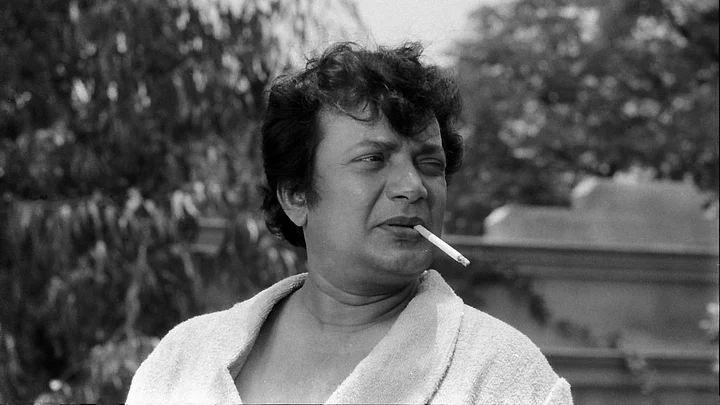(On the birth anniversary of Uttam Kumar, The Quint is republishing this piece in commemoration from its archives. It was originally published on 24 July 2015.)
There are probably two occasions in the history of Calcutta – which actually represent Bengal – when a death became history. The first was the passing of Rabindranath Tagore on 7 August 1941. This is supposed to have caused mass hysteria – thousands of his admirers gathered around his corpse while it was being taken for cremation. Many tore bits off his hair and the famed beard for keepsakes. It was a disaster.
The second time was not so ugly. That was the passing of Arun Kumar Chatterjee in 1980. He was carried, with dignity, in a covered carriage. Nobody had a chance to pull out his beard or moustache, since he did not wear one.
His passing led to entire forests being chopped down, as Bangla media mourned him and made a quick buck. The primitive TV we had then, endlessly, and tiresomely, looped his movies.
Because Arun Kumar Chatterjee had not died: Uttam Kumar had. And my aunts, and everybody else, I daresay, cried their hearts out at his passing.
Two Legends and Their Lives – Uttam and Suchitra
His first few films were flops, and he wanted to pursue a – then lucrative – career as a clerk in the Calcutta Port Trust. Fate, family – they had a culture of doing theatre at home – and his sisters, pushed him back to films. And after his first few flops, what a career he had.
Between 1945 and 1980, he acted in an astounding 375 films, averaging nearly 11 films per year. He played roles in both Bangla and Hindi films, paired against almost every heroine one could think of in those times: from Sabitri Debi and Madhabi Mukherjee, to, much later, Aparna Sen.
But it was the Uttam-Suchitra pair that bowled Bengalis over: with his effete bhadralok image and her innate sophistication and restrained sexuality, it was an unbeatable – and eminently bankable – on-screen combination.
Suchitra Sen opted out of public life in 1979, one year before Uttam’s death. She passed away in 2014, refusing public appearances and rejecting honours, including the Dada Saheb Phalke Award. She remains an enigma, like Greta Garbo.
Being Uttam: No Ordinary Persona
Not so Uttam Kumar. Celebrated in life and death, churning out blockbusters by the dozen, he was designated ‘Mahanayak’ – ‘Great Hero’ – long before he died. Yet, he was not the greatest actor to have starred in Bengali cinema and his heavily accented Hindi ensured that his Bollywood productions didn’t do well at the box office.
Given his persona as the biggest romantic hero of all time in Bangla films, it is perhaps surprising that his two most enduring performances were anything but that. These two occurred back to back, in a turbulent time in Bengal, 1966 and 1967.
The Statesman, Powered by the Auteur
In 1966, Satyajit Ray, the greatest auteur to have emerged from India, got him on board to play the lead in Nayak (Hero). Brilliantly written and crafted by Ray, it traces a 24-hour train journey undertaken by a film star, from Calcutta to Delhi. On the journey, he meets a young woman journalist, eager for a scoop, played by Sharmila Tagore.
As the film progresses, through conversation, flashbacks – and a seriously disturbing dream sequence – all the insecurities and vertigo of stardom are exposed and the Nayak is shown as lonely and vulnerable. Uttam could not have delivered this performance without Ray.
The next year, the two teamed up again, for Chiriyakhana (The Zoo), a psychological thriller set in the suffocating confines of a building inhabited by a bunch of eccentrics, where a judge has been murdered.
On screen, this was the first appearance of Byomkesh Bakshi, the sleuth created by Sharadindu Bandopadhyay and reprised again and again in popular culture since then. Again it took Ray to get the best out of Uttam, a completely uncharacteristic performance from what he used to dish out regularly.
Ray’s Favourite was Never Uttam
Uttam was not Ray’s favourite actor. That honour probably goes to Saumitra Chattopadhyay, who played a middle-aged Apu in Ray’s famous trilogy, Feluda in two outstanding films featuring the sleuth created by Ray, as well as other roles in his films.
Saumitra, with his sharp features and innate intellectual abilities – few know that he is a superb poet in Bangla and a great theatre actor – two skills Uttam could never master, fitted the more urbane sophistication of the post-1960s Bengali.
But of course, Uttam was – and will remain – the Mahanayak. The most bankable star, ever, in Bengali cinema. On the occasion of his birth anniversary today, it is worth noting how much of his prodigious output is utterly unforgettable.
(The writer is a Delhi-based senior journalist.)
(At The Quint, we question everything. Play an active role in shaping our journalism by becoming a member today.)
